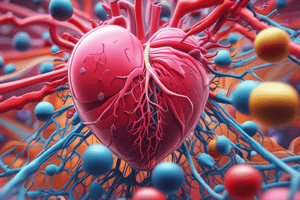Podcast
Questions and Answers
What is the main indication for cardiotonics?
What is the main indication for cardiotonics?
- Arrhythmias
- Hypertension
- Heart failure (correct)
- Hyperlipidemia
Which of the following is NOT a common adverse reaction of cardiotonics?
Which of the following is NOT a common adverse reaction of cardiotonics?
- Muscle weakness (correct)
- Headache and facial pain
- Nausea and vomiting
- Visual disturbances
What is the recommended therapeutic level for serum digoxin in patients receiving cardiotonics?
What is the recommended therapeutic level for serum digoxin in patients receiving cardiotonics?
- 2 - 4 ng/ml
- 0.8 - 2 ng/ml (correct)
- 3 - 6 ng/ml
- 0.5 - 1 ng/ml
In digitalization, what does a loading dose refer to?
In digitalization, what does a loading dose refer to?
Which of the following electrolyte imbalances is NOT a factor that predisposes a patient to digoxin toxicity?
Which of the following electrolyte imbalances is NOT a factor that predisposes a patient to digoxin toxicity?
What is the antidote for serious digoxin toxicity?
What is the antidote for serious digoxin toxicity?
Which of the following is a visual disturbance associated with cardiotonics?
Which of the following is a visual disturbance associated with cardiotonics?
What is the route of administration for cardiotonics?
What is the route of administration for cardiotonics?
'Digitalization' refers to the process of giving a series of doses of a cardiotonic drug until:
'Digitalization' refers to the process of giving a series of doses of a cardiotonic drug until:
Which electrolyte imbalance slows digoxin metabolism?
Which electrolyte imbalance slows digoxin metabolism?
What is the primary indication for the use of phosphodiesterase inhibitors in short-term management of heart failure?
What is the primary indication for the use of phosphodiesterase inhibitors in short-term management of heart failure?
What is a common adverse drug reaction associated with the Class I-A drug Quinidine?
What is a common adverse drug reaction associated with the Class I-A drug Quinidine?
Which drug is used for ventricular tachyarrhythmia and is associated with adverse effects like neurological symptoms and respiratory depression?
Which drug is used for ventricular tachyarrhythmia and is associated with adverse effects like neurological symptoms and respiratory depression?
What is the primary action of Beta Blockers in the treatment of arrhythmias?
What is the primary action of Beta Blockers in the treatment of arrhythmias?
Which Class III drug is considered a first-line treatment for ventricular tachycardia, ventricular fibrillation, and pulselessness?
Which Class III drug is considered a first-line treatment for ventricular tachycardia, ventricular fibrillation, and pulselessness?
What is a common adverse effect of Class IV Ca channel blockers?
What is a common adverse effect of Class IV Ca channel blockers?
Which anti-arrhythmic drug requires monitoring of K levels due to its potential to affect potassium levels?
Which anti-arrhythmic drug requires monitoring of K levels due to its potential to affect potassium levels?
Which anti-arrhythmic drug should be avoided in patients with COPD, PVD, and heart disease?
Which anti-arrhythmic drug should be avoided in patients with COPD, PVD, and heart disease?
What is the primary action of vasodilators in the treatment of cardiac conditions?
What is the primary action of vasodilators in the treatment of cardiac conditions?
What is the main use of Digitalis glycoside drugs like Digoxin?
What is the main use of Digitalis glycoside drugs like Digoxin?
What are the adverse effects of nitrates?
What are the adverse effects of nitrates?
What is the recommended response if a patient experiences acute angina and nitroglycerin provides no relief?
What is the recommended response if a patient experiences acute angina and nitroglycerin provides no relief?
Why is it crucial to take sublingual tablets sitting or lying down?
Why is it crucial to take sublingual tablets sitting or lying down?
Which statement is true about the storage of nitroglycerin sublingual spray?
Which statement is true about the storage of nitroglycerin sublingual spray?
Why is it important to remove nitroglycerin ointment during defibrillation?
Why is it important to remove nitroglycerin ointment during defibrillation?
Why should nitroglycerin transdermal patches be applied to clean, dry, and hairless areas on the chest wall?
Why should nitroglycerin transdermal patches be applied to clean, dry, and hairless areas on the chest wall?
Intravenous nitroglycerin is primarily used for emergency treatment of which condition?
Intravenous nitroglycerin is primarily used for emergency treatment of which condition?
Why is it important to educate patients to change positions slowly while on nitrates?
Why is it important to educate patients to change positions slowly while on nitrates?
What is the purpose of prescribed headache relief (ASA, acetaminophen, ibuprofen) when taking nitrates?
What is the purpose of prescribed headache relief (ASA, acetaminophen, ibuprofen) when taking nitrates?
Why should nitroglycerin be weaned or tapered off when it is discontinued?
Why should nitroglycerin be weaned or tapered off when it is discontinued?
Which Class I-A drug originates from Cinchona bark and has adverse effects like cardiac hypotension, ventricular tachycardia, and hypersensitivity reactions?
Which Class I-A drug originates from Cinchona bark and has adverse effects like cardiac hypotension, ventricular tachycardia, and hypersensitivity reactions?
Which Class I-B drug is indicated for treating post-myocardial infarction premature ventricular contractions (PVC) and digoxin-induced tachyarrhythmias?
Which Class I-B drug is indicated for treating post-myocardial infarction premature ventricular contractions (PVC) and digoxin-induced tachyarrhythmias?
Which Class III antiarrhythmic drug is known for causing photosensitivity, pulmonary toxicity, and hepatotoxicity as adverse effects?
Which Class III antiarrhythmic drug is known for causing photosensitivity, pulmonary toxicity, and hepatotoxicity as adverse effects?
What is the primary action of Class IV Ca channel blockers in the treatment of cardiac conditions?
What is the primary action of Class IV Ca channel blockers in the treatment of cardiac conditions?
Which type of vasodilators is specifically used for insufficient blood flow to the heart muscle due to narrowing of coronary arteries?
Which type of vasodilators is specifically used for insufficient blood flow to the heart muscle due to narrowing of coronary arteries?
Which anti-arrhythmic drug requires monitoring of peripheral circulation, blood sugar levels, and signs/symptoms of congestive heart failure (CHF) as nursing implications?
Which anti-arrhythmic drug requires monitoring of peripheral circulation, blood sugar levels, and signs/symptoms of congestive heart failure (CHF) as nursing implications?
'Cinchonism' is a condition associated with which Class I-A anti-arrhythmic drug?
'Cinchonism' is a condition associated with which Class I-A anti-arrhythmic drug?
'Cardiac: Hypotension, bradycardia, cardiac arrhythmia' are common adverse effects associated with which type of drugs?
'Cardiac: Hypotension, bradycardia, cardiac arrhythmia' are common adverse effects associated with which type of drugs?
Which Class V anti-arrhythmic drug is indicated for bradycardia and acts as an anti-cholinergic?
Which Class V anti-arrhythmic drug is indicated for bradycardia and acts as an anti-cholinergic?
Which medication should be administered with food to avoid GI side effects like N&V, anorexia, and diarrhea?
Which medication should be administered with food to avoid GI side effects like N&V, anorexia, and diarrhea?
What is the purpose of Digitalization in cardiotonic therapy?
What is the purpose of Digitalization in cardiotonic therapy?
Which electrolyte imbalance does NOT predispose a patient to digoxin toxicity?
Which electrolyte imbalance does NOT predispose a patient to digoxin toxicity?
What adverse visual effects are associated with cardiotonics like Digoxin?
What adverse visual effects are associated with cardiotonics like Digoxin?
In the context of cardiotonics, what does the term 'Digitalis Immune Fab (Digibind)' refer to?
In the context of cardiotonics, what does the term 'Digitalis Immune Fab (Digibind)' refer to?
What is the primary route of administration for cardiotonics such as Digoxin?
What is the primary route of administration for cardiotonics such as Digoxin?
Which adverse reaction is NOT typically associated with cardiotonics?
Which adverse reaction is NOT typically associated with cardiotonics?
What is the optimal therapeutic serum level range for Digoxin when used as a cardiotonic?
What is the optimal therapeutic serum level range for Digoxin when used as a cardiotonic?
'Digitalization' refers to which process in cardiotonic therapy?
'Digitalization' refers to which process in cardiotonic therapy?
'Digoxin Immune Fab (Digibind)' functions as an antibody that:
'Digoxin Immune Fab (Digibind)' functions as an antibody that:
'Digitalization' loading dose of Digoxin typically ranges between:
'Digitalization' loading dose of Digoxin typically ranges between:
What is the significance of a throbbing headache when administering nitroglycerin sublingual tablets?
What is the significance of a throbbing headache when administering nitroglycerin sublingual tablets?
Why is it advised to avoid eating, drinking, or smoking for approximately 20 minutes after taking nitroglycerin sublingual tablets?
Why is it advised to avoid eating, drinking, or smoking for approximately 20 minutes after taking nitroglycerin sublingual tablets?
Which action should be taken if a patient experiences no relief from acute angina after taking three doses of nitroglycerin sublingual tablets?
Which action should be taken if a patient experiences no relief from acute angina after taking three doses of nitroglycerin sublingual tablets?
What is the primary indication for using nitroglycerin intravenously?
What is the primary indication for using nitroglycerin intravenously?
Why is it essential to monitor blood pressure, EKG, and oxygen saturation continuously when administering nitroglycerin intravenously?
Why is it essential to monitor blood pressure, EKG, and oxygen saturation continuously when administering nitroglycerin intravenously?
In which location should nitroglycerin transdermal patches be placed to preserve skin integrity?
In which location should nitroglycerin transdermal patches be placed to preserve skin integrity?
What should be done to prevent burns during defibrillation when a patient is wearing nitroglycerin ointment?
What should be done to prevent burns during defibrillation when a patient is wearing nitroglycerin ointment?
What is the recommended interval between doses for acute angina when administering nitroglycerin sublingual tablets?
What is the recommended interval between doses for acute angina when administering nitroglycerin sublingual tablets?
Which adverse effect indicates the potency of nitroglycerin administration when a patient experiences it under the tongue?
Which adverse effect indicates the potency of nitroglycerin administration when a patient experiences it under the tongue?
What should be done to prevent tolerance development when using nitroglycerin transdermal patches?
What should be done to prevent tolerance development when using nitroglycerin transdermal patches?
When applying nitroglycerin ointment, why is it crucial to avoid rubbing it into the skin?
When applying nitroglycerin ointment, why is it crucial to avoid rubbing it into the skin?
What is the primary indication for using nitroglycerin intravenously in emergencies?
What is the primary indication for using nitroglycerin intravenously in emergencies?
Flashcards are hidden until you start studying
Study Notes
- Cardiotonics, also known as cardiac glycosides or digitalis glycosides, are used for conditions like heart failure, atrial fibrillation, atrial flutter, and supraventricular tachycardia.
- They work by enhancing the movement of calcium into myocardial cells, increasing cardiac output through positive inotropic activity, and decreasing conduction velocity through the SA and AV nodes.
- Digitalization involves a series of doses given until the drug exerts its full therapeutic effect, with loading doses ranging from 0.5 to 1.25 mg every 6 to 8 hours initially.
- Adverse reactions of cardiotonics include gastrointestinal issues, CNS symptoms like headache and confusion, visual disturbances, and cardiac effects such as bradycardia and tachycardia.
- Digoxin toxicity can be caused by factors like hyperkalemia, hypokalemia, hypercalcemia, hypomagnesemia, renal impairment, recent MI, IV administration, hypothyroidism, and concurrent treatment with other heart medications.
- Treatment for digoxin toxicity involves holding the dose, treating dysrhythmias with medications like atropine or Dilantin, and administering the antidote Digoxin Immune Fab (Digibind).
- Nursing implications for cardiotonics include monitoring apical heart rate, blood pressure, lung sounds, daily weights, extremities for edema, neck for jugular vein distention, and potassium levels, along with ensuring consistent medication timing, avoiding antacids, and monitoring for adverse effects.
Studying That Suits You
Use AI to generate personalized quizzes and flashcards to suit your learning preferences.




